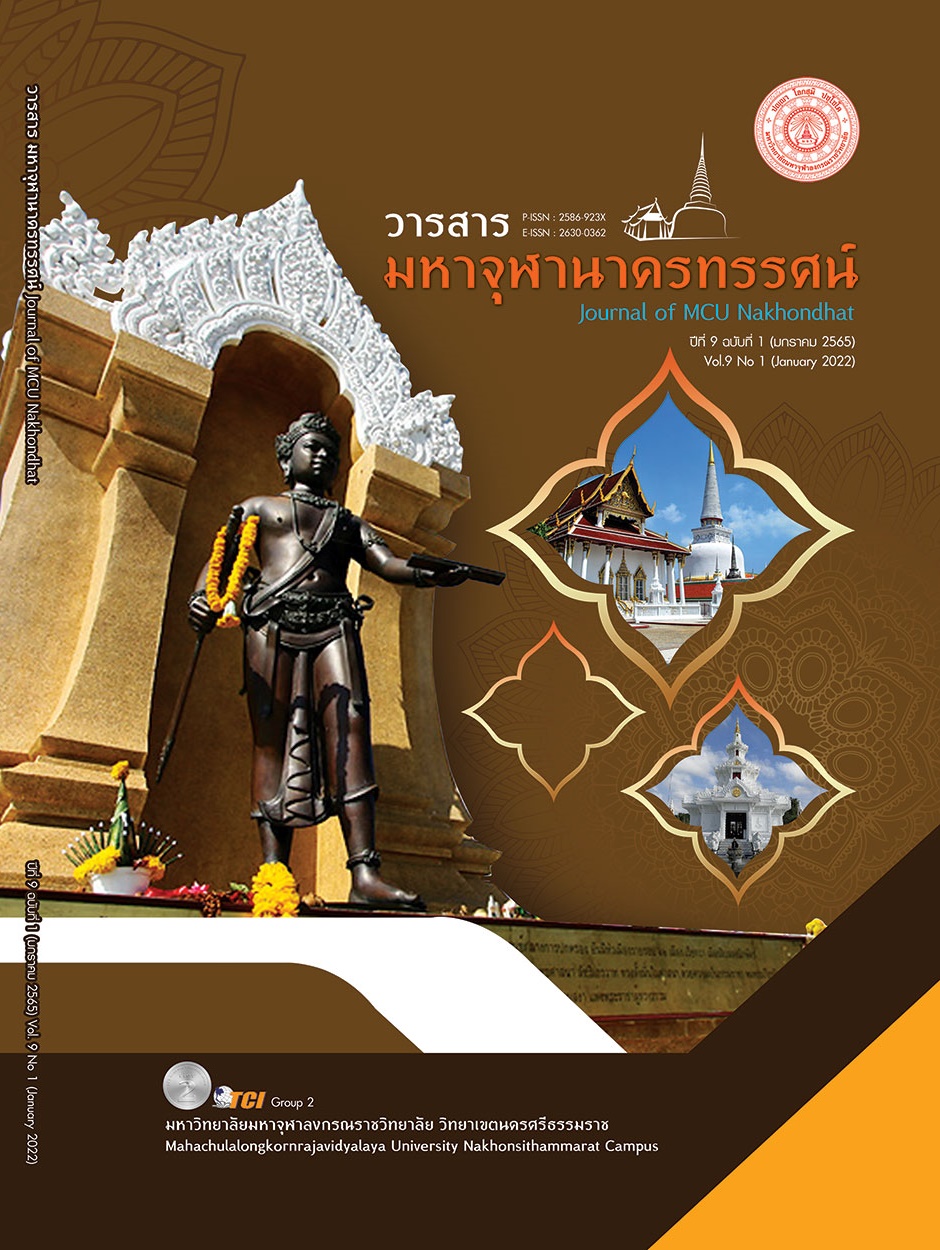GUIDELINES TO RELIEVE FIVE HINDRANCES IN DAILY LIFE
Main Article Content
Abstract
The objectives of this research article were to study five hindrances and problems arising out of five hindrances in daily life, to study the practicing with the five hindrances based on the teaching in the Buddhism and the insight meditation practice acceptable in the Thai society and to propose guidelines to relieve five hindrances in daily life. The research methodology is the qualitative research by document study and field research by in-depth interview of ten general people who have and do not have meditation practice experience and three monk lecturers who teach the practicing with the five hindrances. The research found that a hindrance is a mental formation having power of mental manipulation in an unwholesome way. At the same time, this hindrance is a kind of mind objects which is the instrument for mindfulness practice according to the principle in Mahāsatipaṭṭhāna Sutta. Ordinary people are dominated by the hindrance causing their behaviors in daily life to result in various problems. Based on the teaching in the Buddhism, there are two types of practicing with the hindrances practicing with the hindrances as the meditation object as defilement manipulating mental in an unwholesome way The fundamental Dhamma to be applied is the mindfulness, clear comprehension and perseverance. The practicing with the hindrances based on the insight meditation practice acceptable in the Thai society is to apply the mindfulness, clear comprehension and perseverance and recognize the hindrance as the secondary object or intervention object. The mindfulness, clear comprehension and perseverance are the fundamental Dhamma to be applied to relieve the hindrance in daily life. The mindfulness appropriate for practicing in the daily life is the hand movement of Luangpor Teean Jittasubho, corresponding to the non-stop daily life. The result of hindrance relief is that lives will go with mindfulness and clear comprehension, reducing problems and supporting the intense level of meditation
Article Details

This work is licensed under a Creative Commons Attribution-NonCommercial-NoDerivatives 4.0 International License.
References
พระปลัดสมภาร สมภาโร. (12 มีนาคม 2564). การปฏิบัติต่อนิวรณ์ตามแนวพอง-ยุบ. (เกษมสี สกุลชัยสิริวิช, ผู้สัมภาษณ์)
พระมหาวิเชียร โชติธมฺโม (จันทะมั่น). (2554). การศึกษาสภาวะของนิวรณ์ในวัมมิกสูตร. ใน วิทยานิพนธ์พุทธศาสตรมหาบัณฑิต สาขาวิชาวิปัสสนาภาวนา. มหาวิทยาลัยมหาจุฬาลงกรณราชวิทยาลัย.
พระมหาสมพงษ์ ภทฺทาจาโร. (2551). ศึกษาวิเคราะห์นิวรณ์ ๕ อันเป็นธรรมารมณ์ของวิปัสสนาภาวนา ตามแนวสติปัฏฐาน ๔ เฉพาะกรณีการปฏิบัติวิปัสสนาภาวนา ๗ เดือน. ใน วิทยานิพนธ์พุทธศาสตรมหาบัณฑิต สาขาวิชาวิปัสสนาภาวนา. มหาวิทยาลัยมหาจุฬาลงกรณราชวิทยาลัย.
พระวัฒนชัย กลฺยาโณ. (20 มีนาคม 2564). การปฏิบัติต่อนิวรณ์ตามแนวเคลื่อนไหวมือ. (เกษมสี สกุลชัยสิริวิช, ผู้สัมภาษณ์)
พระสิงห์ทอง เขมิโย. (14 มีนาคม 2564). การปฏิบัติต่อนิวรณ์ตามแนวอานาปานสติ. (เกษมสี สกุลชัยสิริวิช, ผู้สัมภาษณ์)
พระโสภณมหาเถระ (มหาสีสยาดอ). (2549). มหาสติปัฏฐานสูตร ทางสู่พระนิพพาน. แปลและเรียบเรียง โดย พระคันธสาราภิวงศ์ และตรวจชำระโดย พระพรหมโมลี (สมศักดิ์ อุปสโม). กรุงเทพมหานคร: ห้างหุ้นส่วนจำกัด ไทยรายวันการพิมพ์.
พันโท กัมปนาท พุทธปวรางกูร. (2554). ศึกษาธัมมานุปัสสนาในพระพุทธศาสนาเถรวาท. ใน วิทยานิพนธ์พุทธศาสตรมหาบัณฑิต สาขาวิชาพระพุทธศาสนา. มหาวิทยาลัยมหาจุฬาลงกรณราชวิทยาลัย.
พุทธทาสภิกขุ. (2549). มาร - นิวรณ์. สุราษฎร์ธานี: ธรรมทานมูลนิธิ.
มหาจุฬาลงกรณราชวิทยาลัย. (2539). พระไตรปิฎกภาษาไทย ฉบับมหาจุฬาลงกรณราชวิทยาลัย. กรุงเทพมหานคร: โรงพิมพ์มหาจุฬลงกรณราชวิทยาลัย.
สถาบันบรรลือธรรม. (2554). พจนานุกรมฉบับปัญญานันทะ. กรุงเทพมหานคร: ธรรมสภา.
สมเด็จพระพุทธโฆษาจารย์ (ป.อ. ปยุตฺโต). (2561). พจนานุกรมพุทธศาสน์ ฉบับประมวลศัพท์. (พิมพ์ครั้งที่ 31). กรุงเทพมหานคร: บริษัท สหธรรมิก จำกัด.
สุภา มาลากุล ณ อยุธยา. (2560). การศึกษาวิธีการแก้ปัญหากามฉันทนิวรณ์ในพระพุทธศาสนาเถรวาท. ใน วิทยานิพนธ์พุทธศาสตรมหาบัณฑิต สาขาวิชาพระพุทธศาสนา. มหาวิทยาลัยมหาจุฬาลงกรณราชวิทยาลัย.


